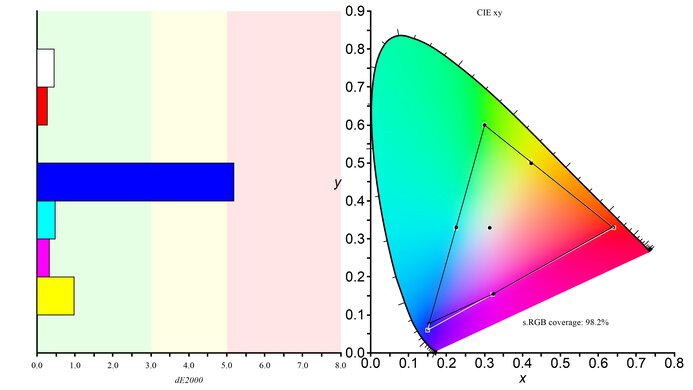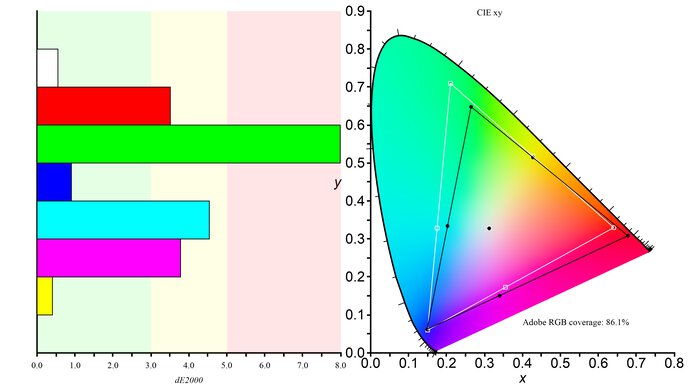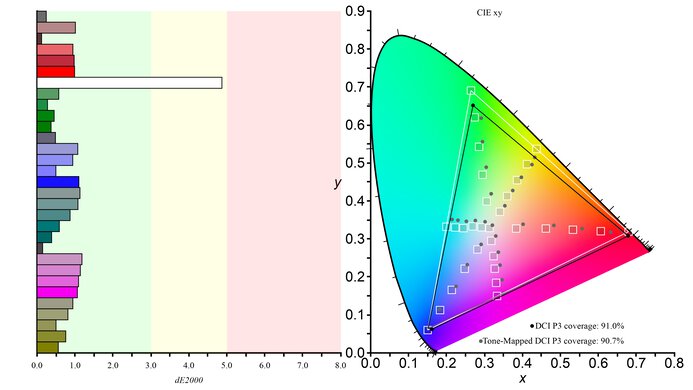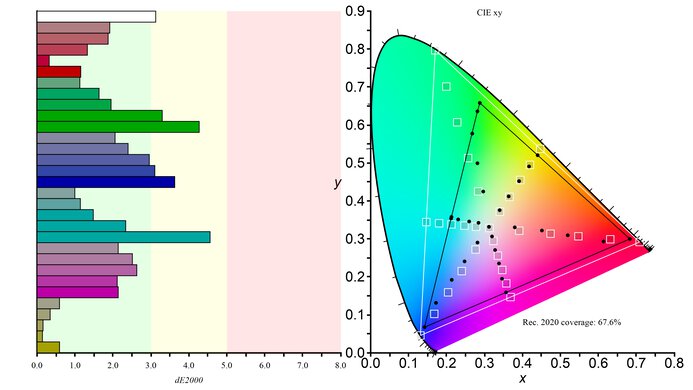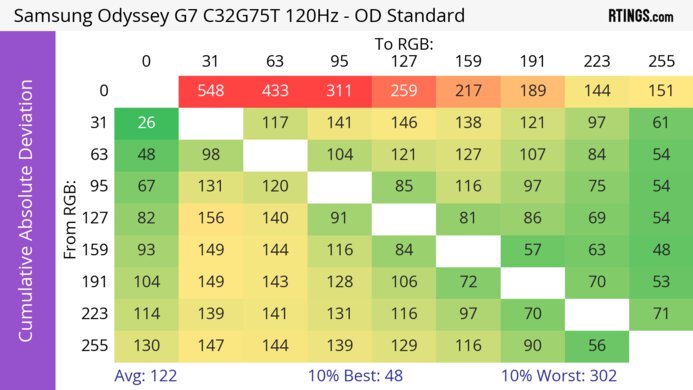The Samsung Odyssey G7 C32G75T is a 240Hz, 1440p gaming monitor. It's part of Samsung's 2020 Odyssey gaming lineup, and it's one of few monitors available in two sizes: 27 and 32 inches, which we tested. It has a 240Hz refresh rate with native FreeSync VRR support to reduce screen tearing. It's also G-SYNC compatible if you want to use it with an NVIDIA graphics card. It has a 1000R curve that helps bring the edges of the screen within your field of vision, and it has a VA panel with edge-lit local dimming, but unlike some of Samsung's models that came out after this one, like the Samsung Odyssey Neo G7 S32BG75, it doesn't have Mini LED backlighting.
Our Verdict
The Samsung Odyssey G7 is good for PC gaming. It has a native 240Hz refresh rate, FreeSync support, and is compatible with NVIDIA's G-SYNC VRR. It has low input lag for a responsive feel with VRR enabled, and it has a consistently fast response time across its VRR range, but there's still some blur with fast-moving objects. The biggest downside is that it has distracting VRR flicker in dark scenes with changing frame rates. On the plus side, it delivers good picture quality with deep blacks, but it has a terrible local dimming feature that causes blooming around bright objects.
- Consistently fast response time at any refresh rate.
- Native FreeSync support and G-SYNC compatibility.
- Great native contrast ratio.
- Low input lag with VRR enabled.
- Noticeable VRR flicker with changing frame rates.
- Fast-moving objects still have smearing.
- Terrible local dimming feature.
The Samsung Odyssey G7 is okay for console gaming. It lacks HDMI 2.1 bandwidth to take full advantage of the PS5 and Xbox Series X|S, but it still provides a good gaming experience with low input lag and a fast enough response time at any refresh rate. It has a high native contrast ratio, so blacks look deep while gaming in dark rooms, but it has a terrible local dimming feature, resulting in blooming around bright objects.
- Consistently fast response time at any refresh rate.
- Great native contrast ratio.
- Low input lag with VRR enabled.
- Fast-moving objects still have smearing.
- Terrible local dimming feature.
- No HDMI 2.1 bandwidth.
The Samsung Odyssey G7 is good for office use. It has a large 32-inch screen with a 1440p resolution, giving you enough screen space to multitask. Sadly, because of its VA panel, it has narrow viewing angles, which isn't ideal for sharing your screen with others. On the upside, it gets bright enough to combat glare, and it has very good reflection handling.
- Very good reflection handling.
- Bright enough to fight glare.
- Good text clarity.
- Narrow viewing angles.
The Samsung Odyssey G7 is decent for media creation. Its 32-inch screen allows you to open multiple windows at once for multitasking. However, the screen's aggressive curve may not be to everyone's liking while photo or video editing. The curve helps bring the edges within your field of vision, but with its narrow viewing angles, it isn't ideal for sharing your screen with others. Lastly, it has good picture quality with a high native contrast ratio, but you need to calibrate it for the best accuracy.
- Great native contrast ratio.
- Very good reflection handling.
- Good text clarity.
- Narrow viewing angles.
- Needs full calibration for best accuracy.
The Samsung Odyssey G7 has decent brightness. It gets bright enough to fight glare in well-lit rooms, and it also makes small highlights stand out a bit in HDR. However, it can't maintain that brightness with larger highlights in HDR.
- Bright enough to fight glare.
- Small highlights pop in HDR.
- Limited HDR brightness with larger highlights.
The Samsung Odyssey G7 has a great response time. It's consistent across its refresh rate range, but there's still some blur and smearing with fast-moving objects.
- Consistently fast response time at any refresh rate.
- Fast-moving objects still have smearing.
The Samsung Odyssey G7 has mediocre HDR picture quality. While it has a high native contrast ratio to display deep blacks, it has a terrible local dimming feature that causes blooming, and it fails to make colors look vivid.
- Great native contrast ratio.
- Terrible local dimming feature.
The Samsung Odyssey G7 has good SDR picture quality. It displays a wide range of colors, and it has a great native contrast ratio, so blacks are deep and inky next to bright highlights.
- Great native contrast ratio.
The Samsung Odyssey G7 has great color accuracy. While its dedicated sRGB mode has good accuracy before calibration, you still need to calibrate it for the best accuracy.
- Good accuracy in sRGB mode.
- Needs full calibration for best accuracy.
Performance Usages
Changelog
- Updated Feb 21, 2025: We've converted this review to Test Bench 2.0.1. This includes a new test result for DisplayPort 2.1 Transmission Bandwidth.
- Updated Jul 03, 2024: Clarified in the Variants section that the results are with firmware 1016.1.
- Updated May 27, 2024: Updated text throughout the review according to Test Bench 2.0, mainly in the Verdict and Motion sections.
- Updated May 24, 2024: Corrected the recommended overdrive setting in CAD @ 60Hz to reflect that enabling VRR results in the best motion handling.
Check Price
Differences Between Sizes And Variants
We tested the 32-inch Samsung Odyssey G7, and the results are also valid for the 27-inch model, known as the Samsung Odyssey G7 27. It's part of the 2020 Odyssey lineup. There's a newer Samsung Odyssey Neo G7 S32BG75 in Samsung's 2022 lineup, but it's a different monitor with a higher resolution.
| Name | Size(s) | US Model | Short Model Code | Refresh Rate | Resolution |
|---|---|---|---|---|---|
| Samsung Odyssey G7 27 | 27" | LC27G75TQSNXZA | C27G75T | 240Hz | 2560x1440 |
| Samsung Odyssey G7 32 | 32" | LC32G75TQSNXZA | C32G75T | 240Hz | 2560x1440 |
Our unit was manufactured in May 2020; you can see the label here. The latest results are with firmware 1016.1.
Popular Monitor Comparisons
The Samsung Odyssey G7 is a good PC gaming monitor that combines a high 240Hz refresh rate with a 1440p resolution. It also has good dark room performance, but its picture quality isn't as good as newer Samsung monitors like the Samsung Odyssey Neo G7 S32BG75. Also, there are many bugs with it, and monitors like the Gigabyte M27Q X and the Dell Alienware AW2723DF offer nearly the same gaming performance for a cheaper cost, so unless you really want a monitor with a VA panel, there are better options.
Also, make sure to check out our recommendations for the best curved gaming monitors, the best 240Hz monitors, and the best 1440p monitors.
The Samsung Odyssey Neo G8 S32BG85 is an upgraded version of the Samsung Odyssey G7 C32G75T. The Neo G8 has a higher 4k resolution and HDMI 2.1 bandwidth that allows it to achieve a 240Hz refresh rate. The Neo G8 also has better overall picture quality because it has Mini LED backlighting, allowing it to get brighter and deliver a better local dimming feature than the G7.
The Samsung Odyssey G7 C32G75T and the Samsung Odyssey G65B S32BG65 are both 1440p monitors with a 240Hz refresh rate, supporting FreeSync natively. The G6 is better for office use because it has better ergonomics and higher peak brightness, but the G7 has a better response time at 60Hz, as well as a more responsive input lag, which makes it better for gaming.
The Samsung Odyssey G7 C32G75T and the Samsung Odyssey G65D S32BG65D are both 1440p, 240Hz gaming monitors, with a few differences. The S32BG65D has HDMI 2.1 bandwidth that you can use to take full advantage of modern graphics cards. The S32BG65D is also the better choice for use in a bright environment, and it supports Tizen OS, which makes it easy to stream content. That said, the C32G75T provides better motion handling at any refresh rate, which is ideal if your PC can't maintain consistently high frame rates.
In name, the Samsung Odyssey G7 S28AG70 is an updated version of the Samsung Odyssey G7 C32G75T, but they're different types of monitors. The S28AG70 is a flat 4k monitor with a 28-inch screen, while the C32G75T is a curved 1440p model available in 27 and 32 inches. The S28AG70 has an IPS panel with wide viewing angles, and the C32G75T has a VA panel with better contrast. In terms of picture quality, the C32G75T is better in a few areas as it gets brighter and has better reflection handling, and even though it has a quicker overall response time, the S28AG70 has better motion handling because there's less black smearing.

We buy and test more than 30 monitors each year, with units that we buy completely on our own, without any cherry-picked units or samples. We put a lot into each unbiased, straight-to-the-point review, and there's a whole process from purchasing to publishing, involving multiple teams and people. We do more than just use the monitor for a week; we use specialized and custom tools to measure various aspects with objective data-based results. We also consider multiple factors before making any recommendations, including the monitor's cost, its performance against the competition, and whether or not it's easy to find.
Test Results

The Samsung Odyssey G7 is a modern-looking gaming monitor with an aggressive curve. Its body is all black with controllable RGB lighting on the bottom bezel and a ring on the back. If you want a VA monitor without a curved screen, check out the LG 32GN650-B/32GN63T-B.
The ergonomics are great overall, and you can easily adjust it. You can even rotate it to a portrait orientation, which is rare for a curved monitor.
The back of the monitor has textured plastic on it, and there's a ring of RGB lighting. The plastic cover comes off the stand so you can place the cables through for cable management, keeping your setup clean.
The Samsung Odyssey G7 has a great contrast ratio, so it displays deep blacks. It has a local dimming feature, but it doesn't improve the contrast much, especially in scenes that leave all the dimming zones on, like with the checkerboard pattern.
Although the contrast is higher than the advertised 2,500:1 ratio, we confirmed our results with multiple measurements using different settings. With 'Black Equalizer' at 10, we measured a contrast ratio of 3,922:1, at '13' it was 3,935:1, and at '20' it was 3,892:1, so it isn't much different from these original numbers. As all of these tests are consistent, we're confident in our measurements.
This monitor has a terrible edge-lit local dimming feature. There are only eight vertical dimming zones, and it takes time for each zone to light up when there are fast-moving objects. It causes uniformity issues when an entire zone lights up, especially in the test pattern, but it isn't as distracting in real content because the algorithm doesn't seem overly aggressive either, and most zones are on all the time. Check out the Samsung Odyssey Neo G7 S32BG75 instead if you want something with better local dimming.
This monitor has great SDR brightness. It gets bright enough to combat glare, but it isn't very consistent with different content. These measurements are from after calibration with local dimming on and brightness set to its max in the 'Custom' Picture Mode. The minimum brightness is a bit high, which can be an issue if you're planning on using it in a dark room and are sensitive to light.
The HDR brightness is just okay. Small highlights are bright enough to stand out, but it's much dimmer with larger areas of bright colors. It tracks the EOTF well, but most scenes are a bit darker than they should be. There's also a sharp cut-off at the monitor's peak brightness, meaning it doesn't perform any tone mapping before your source does. There aren't any picture settings available in HDR, and it locks the brightness to its max.
The Samsung Odyssey G7 has a narrow horizontal viewing angle. The image loses its color accuracy and looks darker as you move off-center, so it isn't ideal for sharing your screen with someone sitting next to you. The curved edges are meant to bring them within your field of vision so that the edges don't look too washed out when you're sitting directly in front of it. If you want a 32-inch monitor with much better viewing angles, then check out the Corsair XENEON 32QHD165.
The Samsung G75T has a narrow vertical viewing angle. Images look inconsistent if you mount the monitor above eye level or view it while standing up.
There are some uniformity issues when displaying a bright object in a dark scene. It looks worse in person than in the photos because the curved screen doesn't show the worst parts. Without local dimming, there's noticeable backlight bleed, and we took a high exposure photo to exaggerate what it looks like, but it isn't really what you see in person. The local dimming feature helps fix any issues, but there are still some problems, as you can see in the photo.
The accuracy before calibration in the sRGB mode is good. Most colors and shades of gray are slightly inaccurate, and the color temperature is a bit warm, giving the image a red/yellow tint. Unfortunately, gamma follows the curve terribly, and most scenes are too dark. The sRGB mode locks a few settings, but other modes have even worse accuracy, as you can see here.
After calibration, this monitor is fantastically accurate. Any remaining inaccuracies aren't noticeable without the aid of a colorimeter, but blue is a bit inaccurate. Gamma is improved and follows the curve almost perfectly.
The Samsung Odyssey G7 32 has a great HDR color gamut. It displays a wide color gamut with excellent coverage of the commonly used DCI-P3 color space, but it has limited coverage of the wider Rec. 2020 color space.
Unfortunately, due to the lack of HDMI 2.1 bandwidth, the refresh rate is limited over HDMI.
| NVIDIA | VRR Min | VRR Max |
| DisplayPort | <20Hz | 240Hz |
| HDMI | N/A | N/A |
| AMD | VRR Min | VRR Max |
| DisplayPort | <20Hz | 240Hz |
| HDMI | <20Hz | 144Hz |
Unfortunately after firmware update 1009.3, you can't enable VRR with the refresh rate in the monitor's OSD set to 60Hz. However, you can still enable VRR if the refresh rate in the OSD is set to anything higher.
| Refresh Rate | CAD Heatmap | RT Chart | Pursuit Photo |
| 239 | Heatmap | Chart | Photo |
| 165 | Heatmap | Chart | Photo |
| 144 | Heatmap | Chart | Photo |
| 120 | Heatmap | Chart | Photo |
| 100 | Heatmap | Chart | Photo |
| 80 | Heatmap | Chart | Photo |
| 60 | Heatmap | Chart | Photo |
This monitor has great motion handling across its VRR range. Enabling VRR disables all of the overdrive settings, and while motion looks worse at lower refresh rates, it's still good enough for gaming.
The refresh rate compliance is great. While its response time isn't fast enough to make full color transitions at its max refresh rate, it's much better at lower refresh rates, especially 60Hz.
| Overdrive Mode | CAD Heatmap | RT Chart | Pursuit Photo |
| Standard | Heatmap | Chart | Photo |
| Faster | Heatmap | Chart | Photo |
| Fastest | Heatmap | Chart | Photo |
| VRR | Heatmap | Chart | Photo |
The CAD at the max refresh rate of 240Hz is great. Motion looks sharp, without much blur trail behind fast-moving objects, but there's smearing and some inverse ghosting. All the overdrive settings perform similarly, including if you use VRR instead.
| Overdrive Mode | CAD Heatmap | RT Chart | Pursuit Photo |
| Standard | Heatmap | Chart | Photo |
| Faster | Heatmap | Chart | Photo |
| Fastest | Heatmap | Chart | Photo |
| VRR | Heatmap | Chart | Photo |
The CAD at 120Hz is great. There's a bit of blur and some smearing, but it isn't terrible, either. All three overdrive settings perform similarly, but there's more ghosting if you enable VRR instead.
| Overdrive Mode | CAD Heatmap | RT Chart | Pursuit Photo |
| Standard | Heatmap | Chart | Photo |
| Faster | Heatmap | Chart | Photo |
| Fastest | Heatmap | Chart | Photo |
| VRR | Heatmap | Chart | Photo |
The CAD at 60Hz is good, as long as you have the refresh rate in the monitor's OSD set to 240Hz, even when it's receiving a 60Hz signal. This is because it has a lot more inverse ghosting if you set the refresh rate in the OSD to 60Hz. Unlike at higher refresh rates, using VRR actually results in the lowest CAD, but this disables any of the overdrive settings, so if you want to use one of the overdrive settings with VRR disabled, then 'Standard' is the best choice.
| Refresh Rate | Motion Blur Photo |
| 240Hz | Photo |
| 120Hz | Photo |
| 60Hz | Photo |
The Samsung Odyssey G7 has an optional backlight strobing feature, commonly known as black frame insertion. You can enable it by setting Response Time to 'Fastest (MBR)'. Although you can enable the backlight-strobing feature as low as 60Hz, it still only flickers at 120Hz, causing distracting image duplication. You can't adjust the brightness of the display when this feature is enabled, but it'll maintain whatever brightness you set before enabling the feature.
Unfortunately, there's a glitch with the feature if you change the resolution of the image or if you turn the monitor off and back on again. Even though the feature is still actively working when you do this, motion looks different with more inverse ghosting. If you experience this, you can simply change the Response Time setting to any other of the three overdrive settings and then back to 'Fastest (MBR)' for it to work properly.
This monitor has terrible VRR flicker with changing frame rates. It's most noticeable in dark scenes, but it's still problematic in dark areas of bright scenes. There's a VRR Control setting that reduces flicker, as you can see here, but it doesn't eliminate all of it. The trade-off is that it has increased Input Lag and there's more stuttering, so you're reducing one issue and getting another with this setting. The best way to avoid this VRR flicker is by setting a frame rate cap to get more consistent frame rates, or disable VRR altogether.
The backlight is flicker-free at all backlight levels, which helps reduce eye strain. It's important to keep in mind that this is different from VRR Flicker that many people online have experienced with different content. We also noticed a different type of flicker with local dimming enabled, and the zones would turn themselves on and off, particularly during our Brightness testing. If you experience the same thing, let us know in the discussions.
This monitor has low input lag for a responsive gaming experience, but only with certain settings, like leaving VRR enabled, which is used for the results above. As of firmware 1013.2, released in Jan. 2022, the input lag varies wildly depending on the settings used in the OSD. Enabling VRR Control and also lowering the refresh rate in the monitor's OSD increases the input lag, as you can see below.
| Settings | 60 Hz | 120 Hz | 240 Hz |
|---|---|---|---|
| VRR Control On | 22.1 ms | 13.8 ms | 9.0 ms |
| VRR Control Off | 9.8 ms | 5.3 ms | 3.1 ms |
| BFI On | 21.3 ms | 14.1 ms | 8.8 ms |
| VRR Off - OSD set to 240Hz | 21.9 ms | 13.8 ms | 8.9 ms |
| VRR Off - OSD matching frame rate | 34.4 ms | 16.6 ms | 8.9 ms |
Although this monitor has a native resolution of 1440p, it can display a 4k signal from a PS5. It results in a downscaled image, which is more detailed than a native 1440p signal but not as detailed as a true 4k display. For this to work, Adaptive Sync has to be disabled on the monitor, and the monitor has to be set to 'HDMI AV' mode.
This monitor supports most common formats from the Xbox Series S|X. Like with the PS5, it can accept 4k @ 60Hz signals as long as you disable VRR and use the 'HDMI AV' mode. Because the Xbox only displays HDR with 4k signals, you also need to use these settings for HDR.
There are a few extra features to improve the user experience. There's RGB lighting on the back that you can customize, and there are Picture-in-Picture and Picture-and-Picture modes if you want to connect two or more sources. The other features include:
- Crosshair: Add a virtual crosshair on the screen for FPS games.
- Black Stabilizer: Adjusts the gamma so you can see opponents in shadows in games.
- Frame Rate Counter: Displays the current frame rate of your signal.



























